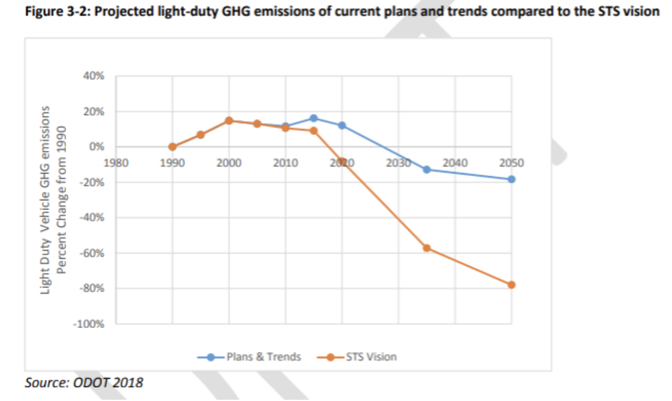The Oregon Global Warming Commission met this week to review the draft of their 2018 Biennial Report to the Legislature. The Commission, created in 2007 to provide oversight on Oregon’s greenhouse gas reduction strategy, detailed that despite our current efforts, Oregon is struggling to make progress, and has actually seen an increase in emissions in recent years – the majority of it coming from the transportation sector (making it all the more notable that the transportation seat on the commission is currently vacant).
I took a look at the report and here’s what I learned…
The report begins with a powerful letter from Commissioner Chair Angus Duncan that begins with a quote from Winston Churchill about WWII: “Owing to past neglect,” Churchill said to the House of Commons in 1936, “In the face of the plainest warnings, we have now entered upon a period of danger…”
Duncan laments that leadership like Churchill’s is sorely lacking in the 21st century. “We’ve looked for that kind of leadership over the 30 years or so that climate change has loomed as an existential threat to our society and our children’s future. Rarely have we found it.” While there are a few bright spots of progress, Duncan writes, “This Letter reflects my profound concern, after ten years as Commission Chair, with whether we are rising to the challenges in meaningful and sufficient ways.”
Duncan’s concern is based in part on the fact that Oregon is no longer seeing a downward trend in emissions, with more than half of the recent increase due to gasoline and diesel. From 2014 to 2016, transportation emissions increased from 35% to 39% of Oregon’s total, while electricity decreased from 30% to 26% during the same period.
So where do we go from here? The answers come from ODOT’s own projections. In 2013 they modeled a Sustainable Transportation Strategy (STS) that, if fully implemented, would reduce all transportation emissions 60% [of 1990 levels] by 2050, and light-duty passenger vehicles by 80%. A 2018 monitoring report done by ODOT shows that we have deviated significantly from this vision, and will likely achieve a 15-20% reduction by 2050 instead.
Several assumptions from their 2012 model have changed: lower fuel prices, strong economy and population growth, and a slower transition to more fuel efficient vehicles than anticipated, with Oregonians hanging onto their vehicles for an average of 12 years. The report points out that when the STS came to the Oregon Transportation Commission (OTC) in 2013 was “accepted” instead of the stronger “adopted”. As a part of the 2018 Oregon Transportation Plan the STS strategies were formally adopted but still have no legal framework for enforcement.
The following recommendations for action were pulled from the 2018 ODOT Monitoring Report:
— Extend the Federal Corporate Average Fuel Economy (CAFE) standards
— Extend the Zero Emissions Vehicle Program
— Extend the Oregon Clean Fuels Program
— Initialize mechanism for true-cost pricing.
True-cost pricing, an important piece of incentivizing other less carbon intensive modes, is still in the future. A few fees from the STS are being considered, such as congestion pricing and pay-per-mile (via the OReGO program) but could still be several years away. A greenhouse gas emissions cap expected to be considered by the Legislature in 2019 is one mechanism to capture true-cost pricing.
Notably absent in this report is the mention of the billions of dollars into highway widening projects as a part of House Bill 2017 (a.k.a. Keep Portland Moving Act) passed during the last legislative session. The previous report, released prior to that 2017 session, recommended strong action to bring transportation back under control. Here’s what the Commission wrote before HB 2017 was created and passed:
In the 2017 session, the Oregon Legislature has an opportunity… to prioritize policies and programs that will make material differences in GHG emissions from transportation… The Commission recommends that the 2017 Legislature… use the occasion to devise and adopt measures that will bring transportation GHG emissions under control…
There is no critical analysis of whether that bill was ultimately aligned with the goals of the Commission or of its estimated impact on transportation emissions. Also not mentioned was the Oregon Public Transportation Plan which was adopted by the Oregon Transportation Commission last month.
Only one line in the report references HB 2017 (emphasis mine): “Although recent funding from the 2017 Keep Oregon Moving Act helps move in the direction of the STS, the levels envisioned in the STS call for exponentially more investment in transit service, along with converting bus fleets – public transit and school buses – to electricity as older buses are replaced.”
It’s going to take a lot of action from ODOT and legislators to push the GHG emissions needle in the other direction. This report — and Duncan’s call for bold leadership — should be a wake-up call for advocates of all stripes.
You can learn more about the Global Warming Commission on their website. Read the full Draft Bienniel Report to the Legislature here (PDF).
— Catie Gould, @Citizen_Cate on Twitter
Never miss a story. Sign-up for the daily BP Headlines email.
BikePortland needs your support.
The post Oregon Global Warming Commission releases draft report to legislature appeared first on BikePortland.org.
from Latest headlines from BikePortland https://ift.tt/2S2K804





No comments:
Post a Comment